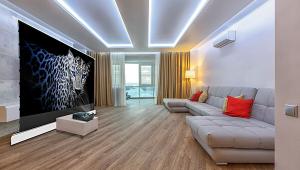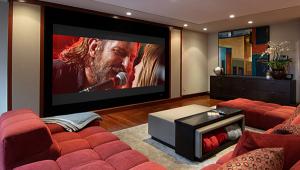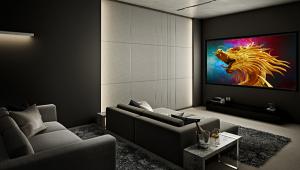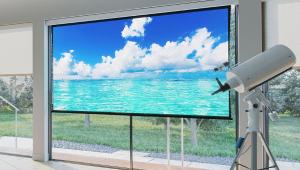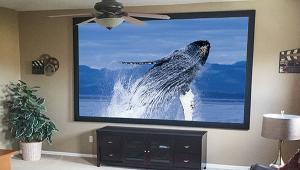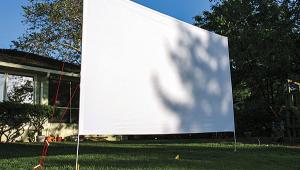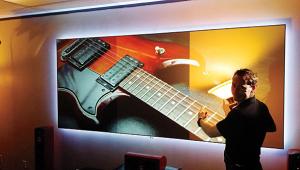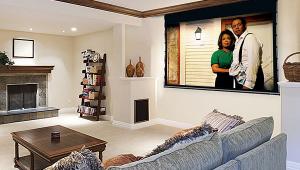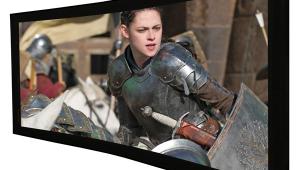Screening Your Room: Stewart Filmscreen StudioTek 100 and StudioTek 130 G3
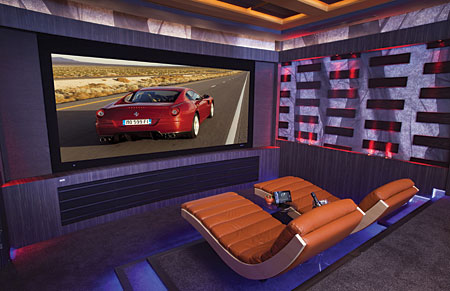
On the other hand, a screen can appear less exciting at first glance. It’s that big white, or gray, or silver thing that sits at the other end of the projection experience. Sure, you need one to actually see the image (unless you belong to the wall-as-a-screen club), but you don’t want to think about it.
That would be a major mistake. The projector and screen are a team. They have to work and play well together to produce the best picture, and your choice of screen will have a serious impact on the performance of your home theater setup.
Dancing in the Dark?
Some screens are designed to minimize the effect of room lighting on the projected image. In general, the darker the room, the better the result. This follows from a simple fact: Projectors do not project black. Black is the absence of light, and a projector can’t produce blacks any darker than the screen appears when the projector is turned off.
Your choice of screen will be constrained by your projector and the size of the image you want. The screen’s aspect ratio—the ratio of its width to its height—is also important. The most popular and practical shape for most homes is 16:9 (or 1.78:1), although other shapes are sometimes used, such as 2.35:1. This is the aspect ratio used for Scope films, named in honor of CinemaScope, the format that first used this wide format back in 1953.
Be aware that image brightness decreases in proportion to the increase in screen area. The black level drops along with the brightness as the screen size increases, so smaller screens perform their best with projectors that offer the deepest blacks to begin with. You should only consider a super-large screen—say over 110 inches wide—if you use a very bright (and likely very expensive) projector. Even 110 inches is pushing things with an affordable projector if you want a bright, punchy image with good color saturation and dimensionality.
Affordable projectors have been getting brighter lately, but the new kids in town are projectors that use LEDs for illumination instead of a projection lamp. They threaten to reverse the trend. LEDs are dimmer than lamps, at least for now. If you’re going the LED route, I’d recommend that you keep your screen relatively small—say at or even below 92 inches wide.
Is Gain Good?
When it comes to choosing the right screen, size isn’t the only consideration. Screen gain also comes into play. Screens with gain don’t actually amplify the light they receive from the projector. Instead, they focus it in a specific way. The higher the gain, the more the screen concentrates the light from the projector toward the center of the screen. However, as gain increases, the brightness in the center of the screen becomes progressively more obvious—a hot spot—and the image dims as your viewing position moves off center. A longer throw distance can reduce the intensity of a hot spot, but it can’t eliminate it. I ran these tests with the front of the projector just over 12 feet from the screen, which is slightly closer than the maximum possible with the zoom lens.
In theory, a screen with a gain of 1.0 is a perfect diffuser. As you move off axis, its brightness shouldn’t change. Screen gains of less than 1.0, with reduced luminance, are also available. Low-gain screens are sometimes used for special purposes, such as edge-blending the images from two or more projectors. Low-gain screens are also useful for improving the black level from a projector that’s too bright for the desired screen size.
Perforated screens (with millions of tiny holes) are available if you like to position your center-channel speaker behind your screen—or all of your front speakers, if the screen is wide enough. But perforated screens sacrifice luminance, as 10 to 15 percent of the light passes through the holes. They may have other issues as well. There’s no free lunch.
Note: The Where to Buy link below is an affiliate link. If you purchase through the link, we may earn a small commission at no extra cost to you. Thank you for your support!
